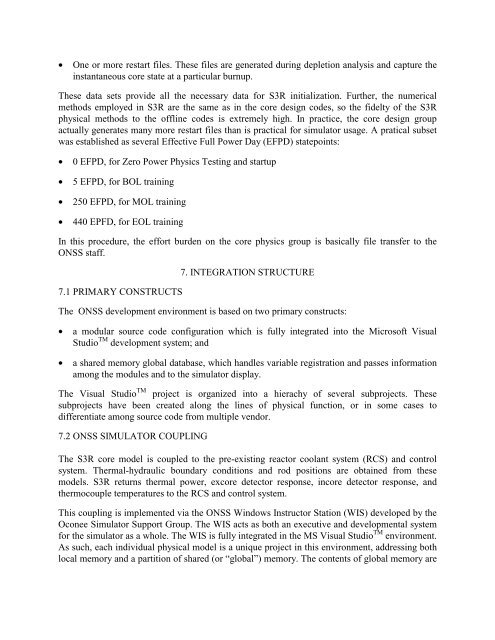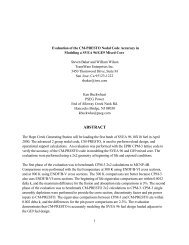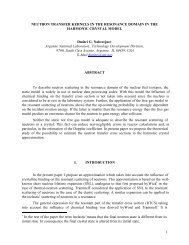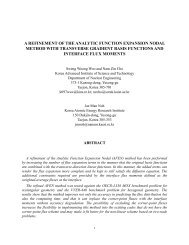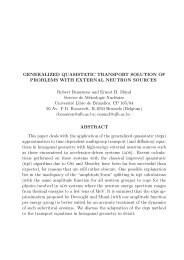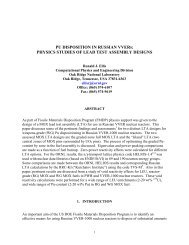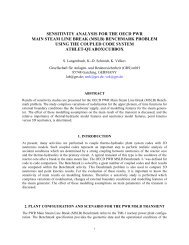J. Borkowski, K. Smith, D. Hagrman, and J. Rhodes, III
J. Borkowski, K. Smith, D. Hagrman, and J. Rhodes, III
J. Borkowski, K. Smith, D. Hagrman, and J. Rhodes, III
Create successful ePaper yourself
Turn your PDF publications into a flip-book with our unique Google optimized e-Paper software.
• One or more restart files. These files are generated during depletion analysis <strong>and</strong> capture the<br />
instantaneous core state at a particular burnup.<br />
These data sets provide all the necessary data for S3R initialization. Further, the numerical<br />
methods employed in S3R are the same as in the core design codes, so the fidelty of the S3R<br />
physical methods to the offline codes is extremely high. In practice, the core design group<br />
actually generates many more restart files than is practical for simulator usage. A pratical subset<br />
was established as several Effective Full Power Day (EFPD) statepoints:<br />
• 0 EFPD, for Zero Power Physics Testing <strong>and</strong> startup<br />
• 5 EFPD, for BOL training<br />
• 250 EFPD, for MOL training<br />
• 440 EPFD, for EOL training<br />
In this procedure, the effort burden on the core physics group is basically file transfer to the<br />
ONSS staff.<br />
7.1 PRIMARY CONSTRUCTS<br />
7. INTEGRATION STRUCTURE<br />
The ONSS development environment is based on two primary constructs:<br />
• a modular source code configuration which is fully integrated into the Microsoft Visual<br />
Studio TM development system; <strong>and</strong><br />
• a shared memory global database, which h<strong>and</strong>les variable registration <strong>and</strong> passes information<br />
among the modules <strong>and</strong> to the simulator display.<br />
The Visual Studio TM project is organized into a hierachy of several subprojects. These<br />
subprojects have been created along the lines of physical function, or in some cases to<br />
differentiate among source code from multiple vendor.<br />
7.2 ONSS SIMULATOR COUPLING<br />
The S3R core model is coupled to the pre-existing reactor coolant system (RCS) <strong>and</strong> control<br />
system. Thermal-hydraulic boundary conditions <strong>and</strong> rod positions are obtained from these<br />
models. S3R returns thermal power, excore detector response, incore detector response, <strong>and</strong><br />
thermocouple temperatures to the RCS <strong>and</strong> control system.<br />
This coupling is implemented via the ONSS Windows Instructor Station (WIS) developed by the<br />
Oconee Simulator Support Group. The WIS acts as both an executive <strong>and</strong> developmental system<br />
for the simulator as a whole. The WIS is fully integrated in the MS Visual Studio TM environment.<br />
As such, each individual physical model is a unique project in this environment, addressing both<br />
local memory <strong>and</strong> a partition of shared (or “global”) memory. The contents of global memory are


